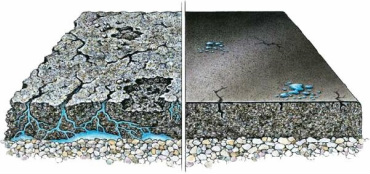Pavement Management Planning & Solutions

Pavement Evaluation:
Asphalt Pavement should be evaluated once every six months or after severe weather seasons to assess the overall condition and to identify potential problem areas. Areas that should be noted are; depressions, upheavals, cracks, alligatoring, loose aggregate and pot holes. Depressions can be of two types. The first are small dents in the asphalt where water might puddle and are relatively simple to fix by filling in with bagged asphalt or liquid material. The second are major areas of sinking and cracking of the asphalt which is called “alligatoring”. This is indicative of problems below the asphalt where the base rock is moving and causing the surface to sink. Alligatored areas should be patched or filled to keep water out. The only permanent fix for alligatoring is to remove and replace the asphalt and add compacted base rock in the area. When evaluating depressions measure the size and depth of the area and note any significant changes. Upheavals are places where the asphalt has risen up causing a bump. Upheavals can be caused by water or roots under the asphalt, frost heave or asphalt and seam failure. Some upheavals can be ground down, but others must be removed and replaced. Cracks are caused by movement in the asphalt, base rock or pressure on the surface of the asphalt. Cracks should be monitored for length, depth and thickness. If you have cracks that are ¼” or larger they need to be filled to prevent water infiltration. Cracks can be filled with either hot or cold applied crack filling material. Loose aggregate or rocks on top of the asphalt are a sign that the asphalt is coming apart. This is caused by erosion and sun damage attacking the asphalt oil which binds the whole expanse of the asphalt. This problem can be addressed in several ways including restorative oils, matting, grinding and overlaying or complete removal and replacement. Potholes are weak spots in the asphalt where a hole is forming. Potholes can be filled with patching material. With all of these problems, the sooner they are addressed the less expensive the solution will be. One of the most effective and least expensive ways to protect asphalt is a regular maintenance program that includes sealcoating. In order to sealcoat asphalt must be dry and properly prepared. (Asphalt Sealcoat Manufacturers Association)
For more in depth info check out:
(The S.C.A.L.E. (Seal coating, Crack sealing, Asphalt, Lot marking Evaluation) Guide was created to explain the lifecycle of a parking lot including probable wear and tear along with maintenance techniques to maximize pavement condition. It is the first reference book of its kind devoted to understanding and rating the surface condition of parking lots. It is designed for use by facility and property managers across the country to aid in the inspection process and prioritization of repairs.)
Maintenance Tips:
As soon as freshly laid hot asphalt begins to cool, the aging process begins. From that moment on, asphalt is broken down by oil, gas, sun oxidation, salt, water penetration, and cold weather. Refer to the following tips when making decisions regarding preventative maintenance on your parking lot(s):
- Carefully inspect your pavement on a regular basis for cracks, fading pavement markings, and other signs of failure or liability issues
- Sealcoating a parking lot helps to slow pavement deterioration; for maximum benefit, asphalt should be sealed every 24-36 months
- Sealcoating should only be performed under the proper weather conditions (50°F during sealer application and for 8 hours afterward)
- Traffic should be kept off a newly sealed surface for 24 hours to allow for drying (curing) time
- Proper attention to cracks will prevent problems from spreading and double the life of pavement
- Singular cracks that are between ¼-inch wide and 1-inch are good candidates for cracksealing
- Crack widening or “routing” is strongly suggested in truck areas, but not in cracks that have already been sealed
- Fixing “birdbaths” as soon as they appear will lessen the chance of water seeping through to the base and becoming a pothole
- Catch basin installation can be a possible solution for improper drainage on a parking lot
- All pre-existing problems such as cracking, low spots, poor drainage, and base or sub-base damage should be resolved before resurfacing pavement
- Concrete is especially durable when it is mixed properly and caution is taken during the curing process
- Concrete needs at least 4-7 days to cure, during which time the surface should be constantly wet
- Lot marking using a “straight-in” design (at 90°) allows for the most stalls and accommodates two-way traffic flow
- According to ADA guidelines, all businesses must have the proper amount of handicapped-accessible parking stalls, and required van parking spaces
